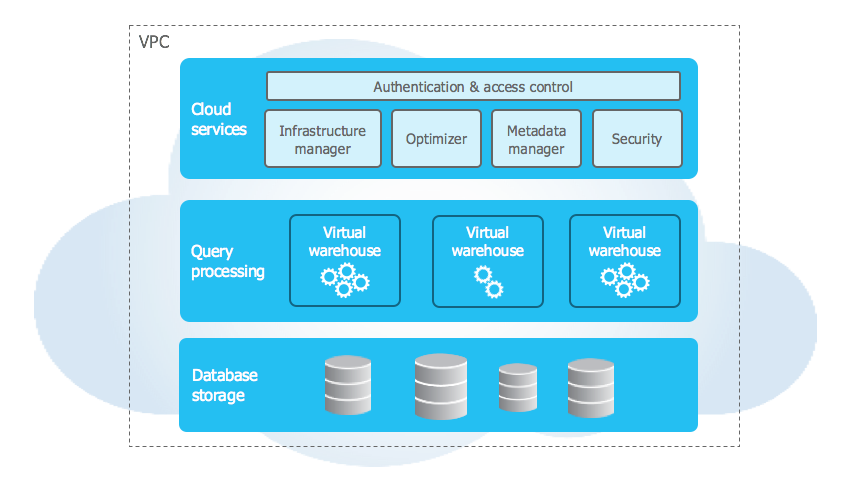How many of your marketing efforts reach your targeted audience? If your answer is a few, you should rethink on the fundamental ways you are reaching your targeted audience. The first stage of marketing involves identifying your audience, and to accomplish that, you need a unified data platform. This often leaves marketing teams grappling with scattered data, resulting in missed opportunities, generic campaigns and underwhelming results.
Snowflake is one such cloud-based data warehousing platform that offers a powerful and scalable solution for storing, processing and analyzing large volumes of data. Snowflake data integration and modeling provides a powerful platform for organizations to connect, transform and model their data.
Snowflake allows the marketing team to consolidate all customer data into a single data repository. With Snowflake’s support for complex SQL queries, they can easily segment customers based on various attributes such as purchase history, browsing behavior and demographics. By using Snowflake’s powerful analytics capabilities, the team can create targeted marketing campaigns tailored to specific customer segments. This leads to higher engagement and improved conversion rates.
Snowflake’s data integration and modeling features
Snowflake is a cloud data platform available as SaaS with an integrated architecture, separating cloud services, storage and compute layers. Separation allows parallel processing of multiple workloads without resource contention. It works on pay-as-you-go model. Snowflake can be hosted on cloud platforms such as AWS, GCP and Azure.

Snowflake’s powerful features like data sharing, cloning, time travel and fail-safe options make it a developer’s delight. The platform supports various data types, stored procedures, streams and tasks to facilitate data transformation and automation.
Snowflake’s capabilities make it a powerful platform for data warehousing, data engineering, data science and secure data sharing across various industries.
Snowflake supports data transformation during loading. Snowflake’s data integration features include:
- Data types – Snowflake Integration Platform supports a rich set of data types, including numeric, string, date-time, logical, semi-structured (variant, array object, geospatial) and unsupported (BLOB, CLOB).
- Stored Procedures – Extend native Snowflake SQL with JavaScript for procedural logic, error handling, dynamic SQL execution and role-based execution.
- Streams – Track changes to tables (inserts, updates, deletes) and metadata with Change Data Capture (CDC).
- Tasks – Automate data ingestion using CI/CD pipelines and task dependencies for sequential execution.
- Snowpipes – Allow continuous data loading in micro-batches from stage files.
– Bulk load using the COPY command – Load data from local files or cloud storage (CSV, JSON, Avro, Parquet, XML, etc.) with data conversion functions.
Snowflake does not provide built-in connectors to other data sources, requiring API calls and data procurement in files for ingestion. Additionally, it does not offer email notifications to inform users of job statuses on the Snowflake integration platform. However, by using the ETL/ELT tools available and ingesting data from Snowflake can address these challenges.
How Snowflake helps in data modeling?
Data modeling is the process of organizing and mapping data using simplified diagrams, symbols and text to represent data associations and flow.
Snowflake supports a wide range of data modeling techniques, including:
- Dimensional modeling: This is a popular data modeling technique that organizes data into a star schema, with a fact table at the center and dimension tables surrounding it. This approach is well-suited for analytical queries, as it allows for fast and efficient access to data.
- Data Vault modeling: This is a more complex data modeling technique that is designed to improve data quality and traceability. Data Vault models are made up of three types of tables: hub tables, link tables and satellite tables. This approach is well-suited for data warehouses that need to track historical data and changes over time.
- Hybrid modeling: This is a combination of dimensional modeling and Data Vault modeling. Hybrid models can offer the best of both worlds, with the performance of dimensional modeling and the data quality and traceability of Data Vault modeling.
- NoSQL modeling: This is a type of data modeling that is used for storing and querying semi-structured and unstructured data. NoSQL models are typically not as well-suited for analytical queries as dimensional models, but they can be more efficient for storing and querying large amounts of data.
In addition to these specific data modeling techniques, Snowflake also supports a variety of other features that can improve the performance and scalability of data models.
- Columnar storage: This type of storage stores data in columns, rather than rows. This can improve performance for analytical queries, as columns are often accessed together.
- Massive parallel processing (MPP): This technology allows Snowflake to distribute queries across multiple servers, which improves performance for large queries.
- Adaptive data warehouse: This technology automatically adjusts the resources allocated to a data warehouse based on demand. This can improve performance and scalability for data warehouses that experience fluctuating workloads.
Snowflake users can benefit from the flexibility of selecting the most suitable data modeling approach from the range of options. This aligns with their specific requirements.
Real-life success stories: Snowflake in action

With the integration of Snowflake, Tripadvisor’s marketing team gained access to a unified view of users, enabling them to launch personalized experiences aligned with their strategic initiatives. Leveraging historical and real-time data, the team hyper-personalized their marketing campaigns, resulting in a more engaging experience for Tripadvisor customers.
Using machine learning and rich member engagement data, they were facilitated advanced customer segmentation and personalized messaging. Notably, Snowflake played a key role in delivering valuable campaigns, such as hotel price drop campaigns. These campaigns which sent deals directly to members based on their browsing history.

Slack uses Snowflake to simplify its marketing data infrastructure, reducing data complexity and accelerating business outcomes. Snowflake’s Secure Data Sharing and RBAC ensure marketing data security, privacy and compliance. Snowflake supports data-driven marketing initiatives on Slack, including data governance, multi-touch attribution, personalized marketing, consent management and conversion optimization.
Slack plans to enhance its multi-touch attribution model and leverage the Snowflake SQL API to provide near real-time access to marketing data. Slack’s marketing team is benefit from Snowflake-powered data infrastructure, enabling more efficient and targeted marketing campaigns.
Partnering with experts for effective Implementation
Snowflake offers a wide range of features that make it easy to connect to data sources, transform data and create models. Snowflake is also scalable and secure, making it a good choice for businesses of all sizes. As companies continue to embrace data-driven strategies, Snowflake data integration and modeling serve as indispensable tools to unlock the true potential of their data assets, paving the way for a data-driven future. With expert guidance from Snowflake consultants, you can effectively implement data integration and modeling best practices. Our customized Snowflake implementation services are tailored to meet your specific requirements, facilitating optimized data processing.









